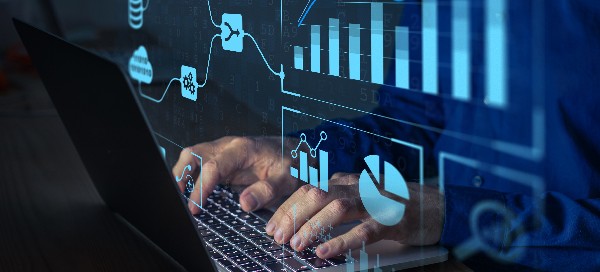The circular economy & e-waste: Achieving a more sustainable future
At the core of nearly every industry and every aspect of our day-to-day lives, there's an option to use something for a short time and throw it away. It's easy. It's fast. And it's hurting the environment. Our growing demand and use of electronic devices and the deliberate choices we all make in how we produce, use, and discard them, are becoming a larger concern for the environment.

At the core of nearly every industry and every aspect of our day-to-day lives, there’s an option to use something for a short time and throw it away. It’s easy. It’s fast. And it’s hurting the environment. Our growing demand and use of electronic devices and the deliberate choices we all make in how we produce, use, and discard them, are becoming a larger concern for the environment.
While the innovations and opportunities that electronic devices and technologies present immeasurable value, —from precise non-invasive surgical procedures to AI research and development —there are two sides to every coin.
With all that innovation and convenience also comes an unprecedented amount of what is commonly referred to as e-waste is produced:
What is e-waste?
We’re now in the midst of massive e-waste generation, a significant carbon footprint, and an increasing demand on the natural world for resource extraction to fulfill the non-stop need for the manufacturing and development of new electronic products. Exacerbating this harmful process, manufacturers develop these products with planned obsolescence in mind – physically designing products to only be useful for a few short years or deliberately building a shorter lifespan into the make and model of the product.
E-waste is now the fastest-growing waste stream in the world, generating 53 million tons of waste in 2019 alone (Ewastemonitor.info). That’s the equivalent of disposing of 800 laptops per second! Left unabated, the annual volume of e-waste generated could grow to nearly 75 million tons by 2030.
The human impact of e-waste
From beginning to end, electronics produce harmful impacts on the environment:
- Mining for precious metals and minerals needed to make these products deplete our environment of natural resources and disrupt surrounding communities.
- Following their disposal, electronics break down and release toxic heavy metals, such as lead, arsenic, lithium, and cadmium, which can leach into the soil and groundwater, be consumed by animals and humans, and lead to health complications.
- E-waste is often incinerated, releasing hydrocarbons in the atmosphere, which contributes to greenhouse gas emissions and significantly pollutes the air that many animals and humans rely on.
- Oftentimes, developing countries become a dumping ground for electronic waste, negatively impacting both the environment and the residents of the countries left to deal with the waste. (Source: Adopted from the Centre for International Environmental Law)
From the very beginning of an electronic device’s “life,” there are opportunities to make a difference rather than simply accept e-waste as an inevitable fact of life in the 21st century. We can rethink electronic waste as a whole and instead work together to take a more circular, sustainable approach to electronics. Both consumers and organisations can make conscious choices about electronic products that support the end goal (i.e. what to do when a device has reached its supposed end-of-life) in a responsible, thoughtful manner that ultimately fosters a more circular economy.
How we approach the end of life of a product and its potential future within the circular economy are not mutually exclusive. Just think – only a few decades ago, as consumers, we went from throwing everything out into the trash, to not only being aware that most items could be re-used or recycled but also changing our behaviors accordingly. It did not happen overnight, but over time new behaviors and new conscious habits around recycling became more of the norm.
Now, consumers have tremendous purchasing power to positively influence manufacturers to confront the harmful realities of wasteful product design and create solutions in the form of refurbished and repurposed electronics over electronics with an intentionally designed “one and done” useful life.
Similarly, organisations across industries must now realise that they can make conscious choices not only around their own role in e-waste generation and disposal, but also how they can change to make a more positive impact. With the help and support of expert partners and vendors, organisations can prioritise education and then transition into creating new, more sustainable behaviors that modify current business practices and support their goals in an environmentally responsible way.
Here’s a brief overview of how to begin working toward a Circular Economy of electronics:

Through reporting on critical data around landfill diversion, waste generation, and recycling rates, companies can proactively and transparently confront their own role in contributing to a more circular, sustainable future. Many companies are already required to report these numbers, but by making changes–big or small–to how they dispose of or repurpose their electronic devices, they can easily meet or exceed reporting goals while making a significant environmental impact.
Remarketing, the process of refurbishing, data erasure, and reselling to a new owner is a positive and secure alternative to simply disposing of electronic products. Importantly, remarketing or repurposing these materials can be up to 20 times more efficient than simply disposing of them. By working with a secure vendor, companies can ensure that confidential information is protected and safely wiped from remarketed devices, thereby eliminating security risk. As an added benefit, companies are also able to recapture the value in their electronics.
As suppliers and consumers, individuals and companies, we can’t necessarily reverse the impact e-waste has already had on the environment. But by reframing our view of electronic waste and making deliberate choices that help shift our focus to a more circular approach to the lifecycle of our electronic devices, we can create a new, more sustainable future. A future where precious resources are not continuously extracted, used and then discarded, but rather reused in thoughtful, innovative, and environmentally friendly ways.
Featured services & solutions
Corporate responsibility at Iron Mountain
At Iron Mountain we understand the impact of our actions in our society and our planet. That's why our social corporate responsibility commitment is present on everything we do.
Rethink sustainability
At Iron Mountain, we strive to be our customers’ most trusted partner for protecting and unlocking the value of what matters most to them in innovative and socially responsible ways
Elevate the power of your work
Related resources
View More Resources
Iron Mountain Clean Start®

